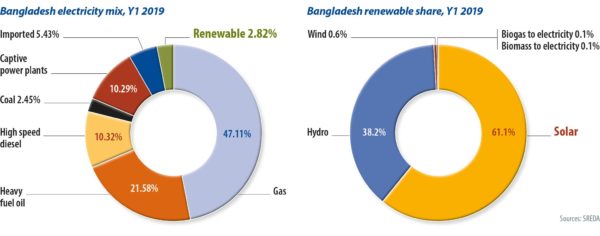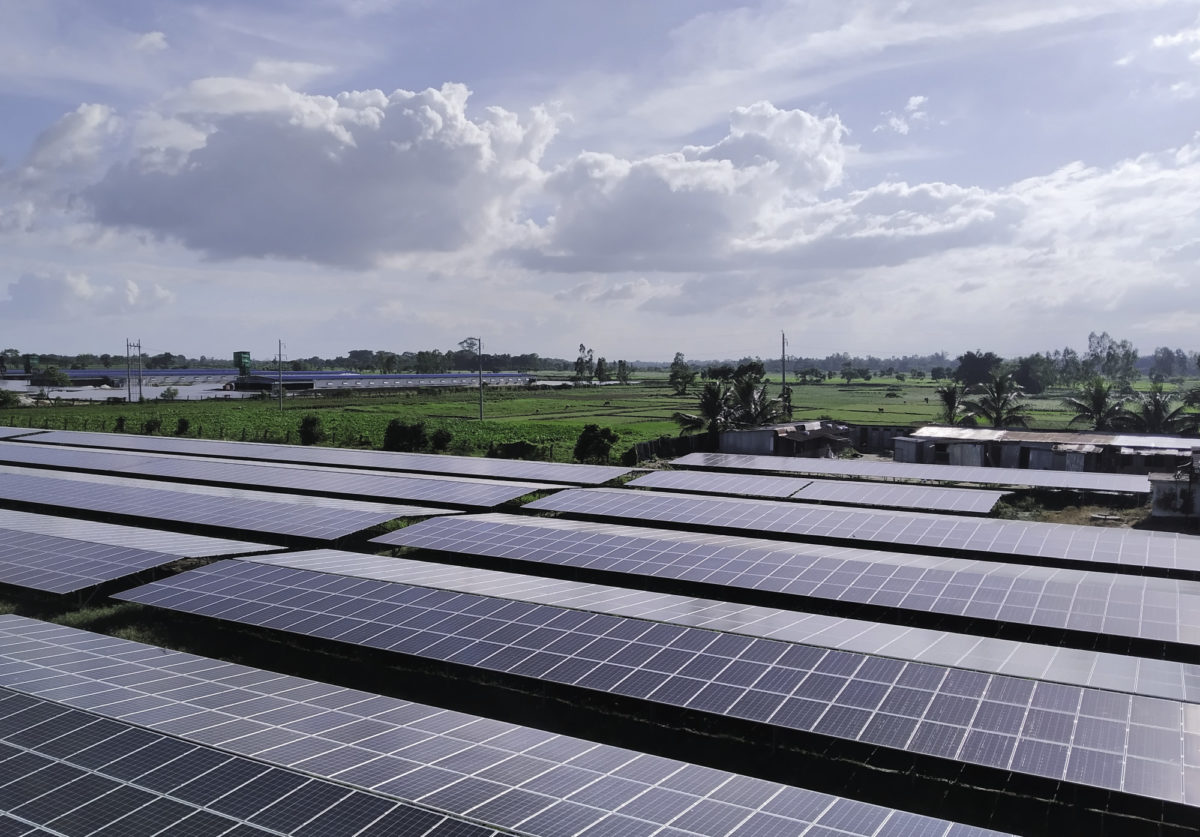From pv magazine, September 2019
While 600 MW of installed renewable capacity may not seem like cause for celebration when compared to more developed and larger economies, Bangladeshi government officials and private sector players are pleased. The milestone is a true achievement for a densely populated country in which land for PV power plants is particularly scarce.
By the middle of this year, 18.2 MW of renewables, mainly solar, had gone online in Bangladesh. About 15.4 MW of the total was connected to the grid, while 2.8 MW was off-grid. In 2018, 74.8 MW of new capacity went online, including 34.7 MW of on-grid installations and 40.1 MW of off-grid projects.
This year’s additions of on-grid solar are mainly concentrated on the rooftops of industrial facilities, which are encouraged to produce power through the country’s net metering scheme. Under this system, a producer can “store” its unconsumed electricity on the national grid.
The installed capacity under this net metering system has already crossed the 10.25 MW mark, and a massive boost is soon expected, as the government has decided to install solar systems on the rooftops of all educational institutions across the country.
Bangladesh Railway, meanwhile, announced plans in late July to set up rooftop solar plants in its stations, office buildings, junctions and workshops throughout the country, to enhance green energy generation. Infrastructure Development Co. Ltd. (IDCOL), a state-owned financier, will provide low-cost financing to support the installations. The first phase of the railway program will add 100 MW of solar capacity to the grid.
Falling costs
On August 4, the Bangladesh Power Development Board received proposals from five bidders to set up 45-55 MW of grid-tied solar in Rangunia, in Chittagong district. The lowest bid came from a consortium of Metito Utilities, JinkoSolar and Al Jomaih Energy and Water, with a project bid of $0.0749/kWh – the lowest ever recorded in Bangladesh’s history. The second-lowest bid – from a consortium of Joules Power, WAC Logistics and Jiangsu Zhongtian – offered $0.0875/kWh, which was also much lower than anything seen in the previous tender. In the past, bids had hovered around the $0.10/kWh mark.

Siddique Zobair, a member of the Bangladeshi Sustainable and Renewable Energy Development Authority (SREDA), told pv magazine that solar generation costs in Bangladesh are falling due to low-cost loans from government initiatives and foreign financiers. “Once, cost was a major barrier for solar,” said Zobair. “Now it is at par with fossil fuel-fired power, even in some cases cheaper.”
Big solar plants
The country’s first solar IPP, a 20 MW (AC) plant, was commissioned in September 2018 by Technaf Solartech Energy Ltd. (TSEL), a subsidiary of Joules Power in the Southeastern Cox’s Bazar district.
Other recent solar projects include an 8 MW plant in Panchagar and a 7.4 MW installation in Kaptai. Beyond that, most plants that have been developed in Bangladesh thus far have been below 3 MW in size.
Nuher Latif Khan, managing director of Joules Power, says that while the implementation of solar power plants has been slow, there is still a lot of optimism in the country’s nascent renewables sector. “Bangladesh offers a very strong power purchase agreement and is supported by an Implementation Agreement, which makes such deals very robust from a bankability perspective. The project yields also range into double digits, which makes it a very attractive investment appraisal,” he says.
Khan said that investment confidence will continue to grow, as the sector is already expanding at a much faster rate now, if the government comes forward to provide land and ensure that evacuation and transmission facilities are in place for private sponsors.
Development deadlines
The Bangladeshi government has awarded more than 1 GW of solar capacity in recent years. Of this total, PPAs have been signed for just six projects, or 532 MW.
But private sector investors say a dearth of available land still stands in the way of Bangladesh’s solar power development plans. The country’s population density is 1,115 people per square kilometer.
A senior official at Exelon Bangladesh, a solar EPC service provider, agrees that land availability is the biggest constraint for solar in the country.
The official argues that the rooftop PV segment will have an excellent future if proper financing arrangements can be ensured for developers.
“The government should initiate its own bidding process, along with the RPO target for each sector, along with private carbon footprint producer. The policy should be clear and encouraging for the commissioning process,” says the Exelon official.
Government and energy sector officials, however, attribute failures in securing financing as the main reason behind project delays. Power Division Joint Secretary Mohammad Alauddin said that some companies fail to arrange funds, and thus miss project development deadlines.
Floating solar
Some project developers are now working on floating solar power plants in Bangladesh. At least three such plants are under development: a 50 MW plant on Kaptai Lake in Chittagong district, a 15 MW array in Mongla, and another project on a 10-square-kilometer section of the Padma River in Manikganj, although the total capacity has yet to be decided.
The Kaptai Lake plant will be supported by funding from the Asian Development Bank (ADB), says Mohammad Alauddin, joint secretary of the power division of the Ministry of Power, Energy and Mineral Resources. The feasibility study for the plant will start soon.
Solar EPC Development Ltd. (SEPC), meanwhile, will build the 15 MW floating solar power plant at the Port of Mongla. SEPC is currently working on an additional pipeline of utility-scale, floating, and canal-related projects, with a cumulative capacity of more than 100 MW.
“As a country of scarce land, we have shifted our focus toward floating solar. Bangladesh has many rivers, a large number of [wetlands], and millions of big and small ponds, which could be an option to develop utility-scale floating solar projects,” Ezaz Al Qudrat A Mazid, the founder and CEO of SEPC, told pv magazine. “Our 15 MW floating project at Mongla will be a new journey to a new path.”
Dynamic Green Energy Ltd., meanwhile, will build the floating solar power plant in Manikganj district. Fazle Elahi Chowdhury, Dynamic Green Energy’s managing director, said the project’s production capacity will be finalized after the completion of a feasibility study.
More projects
In late June, the Bangladesh Power Development Board (BPDB) tendered 100 MW of capacity for two grid-tied solar power plants in Chuadanga and Netrokona districts. BPDB sought sponsors to develop the power plants on a build, own and operate basis.
In mid-June, the government also approved plans to develop a 50 MW solar power plant in Manikganj district. Bangladesh’s SS Agro Complex and two unspecified German companies will build the plant. The government will buy electricity from the project for 20 years at a cost of $0.10/kWh.
Bright future
In Bangladesh, solar power was first introduced to light village homes by small-scale solar home systems. Now about 5.5 million such PV systems are providing light for millions of people, with a total cumulative capacity of about 233 MW.
To date, solar is also powering 1,392 irrigation pumps, with a combined capacity of 30.45 MW. In addition, 102,190 streetlights consume 4.2 MW of solar capacity, and 1,933 solar telecom towers provide 8 MW of capacity in total.
Dipal C. Barua, the president of the Bangladesh Solar and Renewable Energy Association, said that given the progress thus far, the future of solar power in Bangladesh is very bright. He points to the potential for rooftops to generate gigawatts of electricity to feed the power-hungry nation, he said. “The low-cost loan with 6% to 9% interest is also a plus point in investing in the solar sector,” he adds.
By Syful Islam
This content is protected by copyright and may not be reused. If you want to cooperate with us and would like to reuse some of our content, please contact: editors@pv-magazine.com.








By submitting this form you agree to pv magazine using your data for the purposes of publishing your comment.
Your personal data will only be disclosed or otherwise transmitted to third parties for the purposes of spam filtering or if this is necessary for technical maintenance of the website. Any other transfer to third parties will not take place unless this is justified on the basis of applicable data protection regulations or if pv magazine is legally obliged to do so.
You may revoke this consent at any time with effect for the future, in which case your personal data will be deleted immediately. Otherwise, your data will be deleted if pv magazine has processed your request or the purpose of data storage is fulfilled.
Further information on data privacy can be found in our Data Protection Policy.